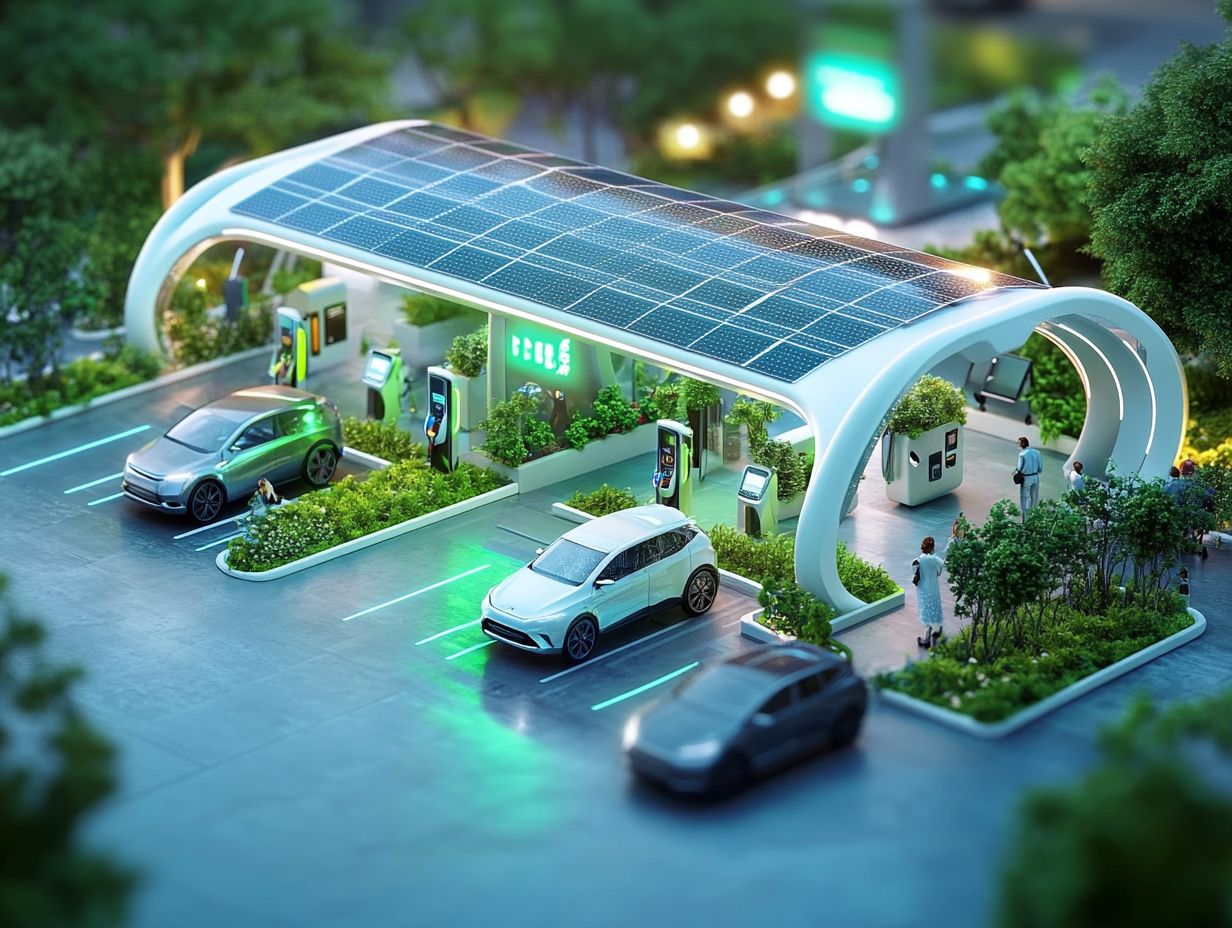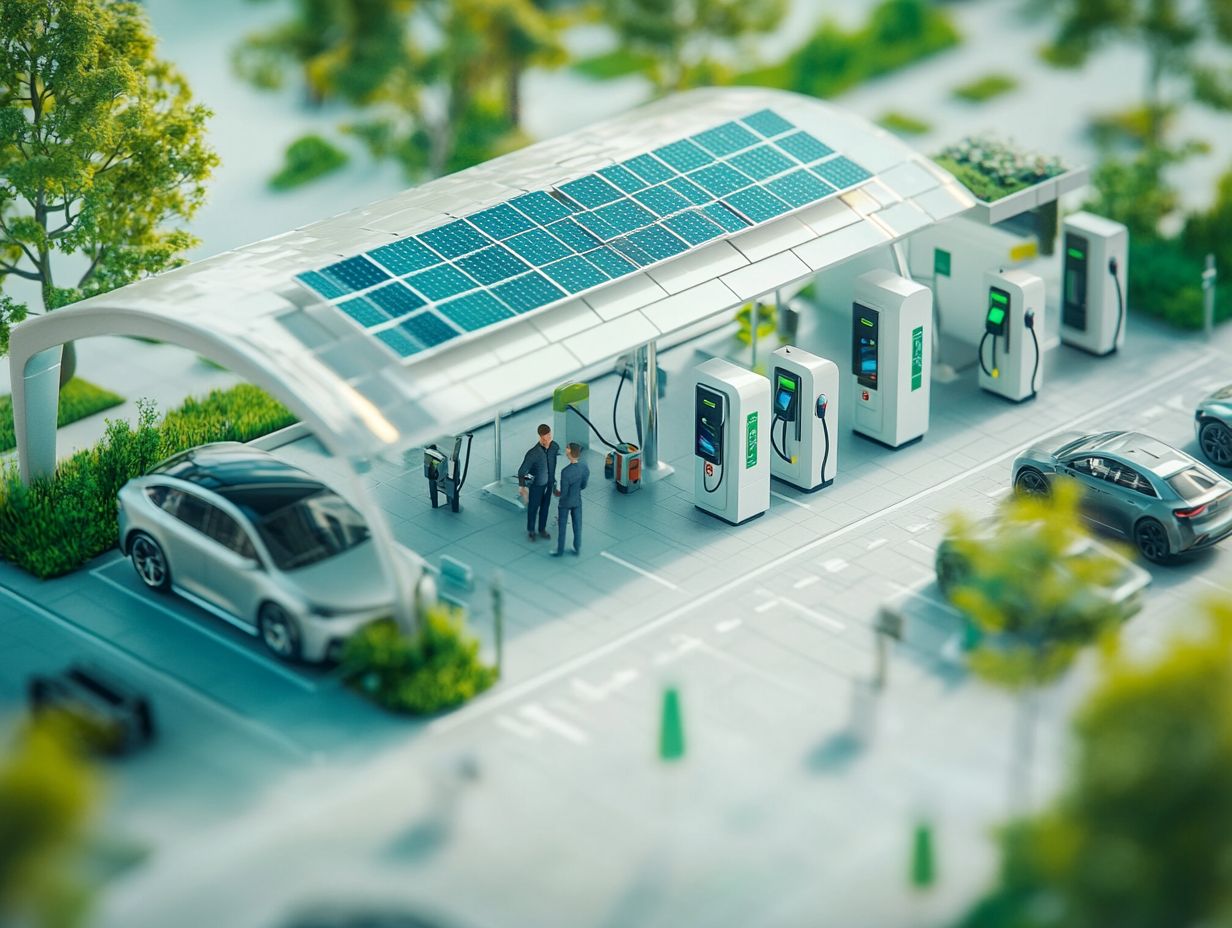The Future of EV Charging Stations Explained
As electric vehicles (EVs) continue to rise in popularity, it’s essential to grasp the landscape of EV charging stations. Exciting changes are happening in EV charging infrastructure right now! This article delves into their current state, shedding light on the existing challenges and limitations within the infrastructure.
You ll find insights on forthcoming advancements that promise to enhance both convenience and accessibility. The benefits environmental and economic are substantial, and we ll guide you through the steps necessary to effectively utilize these charging stations.
We will tackle common barriers to EV adoption. You’ll discover solutions aimed at promoting wider usage. Together, you ll navigate the future of EV charging stations and their pivotal role in a sustainable transportation ecosystem.
Contents
- Key Takeaways:
- The Current State of EV Charging Infrastructure
- The Future of EV Charging Stations
- Benefits of EV Charging Stations
- How to Utilize EV Charging Stations
- Overcoming Barriers to Adoption
- Frequently Asked Questions
- What is the future of EV charging stations?
- How will EV charging stations evolve in the future?
- Will there be enough EV charging stations to meet the growing demand?
- What role will renewable energy play in the future of EV charging stations?
- What challenges could arise in the future for EV charging stations?
- How Will EV Charging Stations Shape Our Environment?
Key Takeaways:

- The future of EV charging stations is bright, with advancements in technology and infrastructure making it easier and more convenient for drivers to charge their electric vehicles.
- EV charging stations offer numerous benefits, including reducing carbon emissions and saving drivers money on fuel costs.
- To utilize EV charging stations, drivers can follow simple steps and overcome barriers to adoption by addressing concerns and promoting usage.
What are EV Charging Stations?
EV charging stations are places where you can charge your electric car. They provide the power you need to keep your vehicle running smoothly, allowing you to conveniently charge your electric car and elevating your overall experience.
As you navigate the landscape of clean energy, you’ll find various charging solutions that cater to your needs whether it s fast charging on the go or home charging for everyday use. These stations are designed to meet the diverse requirements of the expanding electric vehicle market, particularly the increasing demand for public charging facilities.
Understanding the different types of charging stations Level 1, Level 2, and DC fast chargers, which provide quick charging for long trips will deepen your appreciation of their significance. Level 1 chargers, typically found in residential areas, offer the slowest charging speeds, perfect for overnight charging. On the other hand, Level 2 chargers are readily available in public locations and provide a quicker option for those on the move. For long-distance travel, DC fast chargers are a game changer, delivering rapid charging capabilities that keep you on the road.
With more investment in charging infrastructure, you’ll see more stations available soon. The availability of these stations not only enhances your access to charging locations but also builds your confidence in electric mobility. This, in turn, drives higher adoption rates and elevates your satisfaction as a user.
The Current State of EV Charging Infrastructure
The current landscape of EV charging infrastructure is undergoing a remarkable transformation, driven by pivotal initiatives like the Bipartisan Infrastructure Law and the Inflation Reduction Act. These measures are designed to elevate the charging network throughout North America.
As the Biden administration advocates for increased investment in charging stations, the urgency of these infrastructure needs becomes more pronounced, essential for promoting the widespread adoption of electric vehicles and significantly cutting vehicle emissions in the consumer market.
Existing Challenges and Limitations
Despite the strides made in EV charging infrastructure, you may still encounter several challenges that hinder the growth of electric vehicle adoption. Worry about running out of battery before reaching a station and high charging costs can certainly give you pause, making the transition to electric mobility feel less satisfying and trustworthy.
Inconsistent availability of charging stations only adds to the frustration, often leaving you with limited options when plotting long journeys. The financial aspect of purchasing an EV also weighs heavily on your mind; many potential buyers feel apprehensive about the initial investment compared to traditional vehicles.
These market shortcomings, combined with the complexities of navigating charging solutions, greatly affect your decision-making, leading to hesitance in fully embracing electric mobility. Therefore, improving the overall consumer experience is crucial to overcoming these obstacles and cultivating a more robust and sustainable EV market.
The Future of EV Charging Stations

The future of EV charging stations looks exceptionally promising, especially with the rise of solar-powered EV charging stations that highlight remarkable advancements in technology and a competitive market prioritizing faster charging speeds and enhanced consumer satisfaction.
With initiatives like the North American Charging Standard gaining traction, the vision for a sustainable future in electric mobility is becoming more attainable than ever. This progress builds your confidence, making it an exciting time to embrace electric mobility.
Advancements in Technology and Infrastructure
Technology and infrastructure are transforming EV charging stations. With fast charging capabilities and smarter battery manufacturing techniques becoming prominent, the latest on EV charging technology is elevating charging efficiency, significantly reducing overall charging times. This makes the experience much more convenient for you as an EV driver.
New charging solutions are emerging, featuring high-power chargers and ultra-fast options that can rejuvenate batteries in mere minutes. Developments in battery technology, like solid-state batteries batteries that use solid materials instead of liquids are paving the way for longer-lasting and safer energy storage solutions.
As these advancements gain momentum, they address common infrastructure needs, ensuring a seamless experience for you, whether you re at home or on the go. This shift encourages electric vehicle adoption and boosts your confidence in moving away from traditional gasoline-powered cars.
Benefits of EV Charging Stations
The advantages of EV charging stations extend beyond mere convenience and accessibility. They are vital in promoting a cleaner environment while driving economic growth.
By reducing vehicle emissions and enhancing a comprehensive charging network, these stations elevate consumer satisfaction and pave the way for increased investment in electric mobility solutions.
Environmental and Economic Benefits
The environmental and economic benefits of EV charging stations are closely linked. They play a crucial role in reducing greenhouse gas emissions while strengthening the electric mobility sector. This transition helps mitigate environmental impacts and creates jobs, stimulating local economies.
For every Level 2 charging station you install charges providing an excellent balance of speed and convenience about five jobs are generated in installation, maintenance, and operation. This significantly boosts local economies. A report from the International Energy Agency suggests that widespread electric vehicle adoption could lead to a 30% reduction in carbon emissions by 2030, highlighting long-term environmental advantages.
As cities ramp up investments in EV infrastructure, now is the time to take advantage of decreased energy costs. This surge in electric mobility fosters a cleaner environment and acts as a catalyst for further investments in sustainable energy solutions.
How to Utilize EV Charging Stations

To utilize EV charging stations effectively, prioritize a seamless charging experience and minimize your charging time. Familiarizing yourself with the range of charging solutions available and identifying the most advantageous charging locations will significantly enhance your vehicle’s efficiency and convenience on the road.
Explore your EV charging options today and consider making the switch to electric vehicles!
Steps for Charging an Electric Vehicle
Charging your electric vehicle is easy, making your experience at any EV charging station smooth and enjoyable. By understanding the different charging levels and how to connect your vehicle, you can enhance your overall experience and build confidence in electric mobility.
First, it’s essential to familiarize yourself with the available charging levels: Level 1, Level 2, and quick charging stations that use direct current (DC fast charging). Each offers unique speeds and requirements. Level 1 uses a standard household outlet. Level 2 employs a dedicated charging station for quicker charging times. If you’re in a hurry, quick charging stations provide the fastest solution.
Once you’ve identified the appropriate charging level, the next steps involve locating a compatible charging station, ensuring your EV’s charging port is accessible, and properly connecting the charging cable. These simple actions lead to an efficient charge, significantly contributing to your satisfaction and making electric vehicle ownership a seamless experience.
Overcoming Barriers to Adoption
To realize a sustainable future, we must overcome barriers to EV adoption. This means addressing the concerns of potential buyers head-on.
We must tackle factors like inadequate infrastructure investment and limited charging solutions to create a more accessible and inviting market for electric vehicles. Focusing on these issues will help pave the way for broader acceptance and a greener tomorrow.
Addressing Concerns and Promoting Usage
Addressing consumer concerns is vital for promoting the adoption of electric vehicles (EVs) and facilitating a seamless transition to this new era of transportation. Advocating for supportive government legislation and increasing public investment can ease worries about charging accessibility and costs, paving the way for a more vibrant EV consumer market.
Many potential buyers hesitate, gripped by the fear of running out of battery power during long trips a phenomenon known as range anxiety. We must rapidly expand the network of fast-charging stations in both urban and rural areas to ease these concerns.
Educational campaigns that emphasize the long-term cost benefits of electric vehicles compared to traditional fuel-powered cars can help shift consumer perceptions. By highlighting incentives like tax credits and rebates, governments can encourage broader EV adoption, fostering an environment where consumers feel confident and well-informed about their choices.
Frequently Asked Questions

What is the future of EV charging stations?
The demand for electric vehicles is rising, making the future of EV charging stations promising.
How will EV charging stations evolve in the future?
In the future, EV charging stations are expected to become more advanced and widespread, playing a crucial part in the role of charging stations in EV ecosystems. This includes the use of smart technology, faster charging capabilities, and increased integration with renewable energy sources.
Will there be enough EV charging stations to meet the growing demand?
Plans are underway to increase the number of EV charging stations to meet the growing demand. Governments and private companies are investing in expanding the charging infrastructure to make it more accessible for EV owners.
What role will renewable energy play in the future of EV charging stations?
Renewable energy sources, such as solar and wind power, will play a significant role in the future of EV charging stations. These sources will help meet energy demands for charging and reduce the carbon footprint of electric vehicles, highlighting the importance of sustainable EV charging solutions.
What challenges could arise in the future for EV charging stations?
One potential challenge is the strain on the power grid. As more people switch to electric vehicles, demand for electricity will increase, which could lead to power outages and other issues if not properly managed.
How Will EV Charging Stations Shape Our Environment?
EV charging stations will be good for the environment.
By using clean energy sources, like sunlight and wind, we can cut down on fossil fuel use.
This shift will help create a greener, more sustainable future for everyone.






